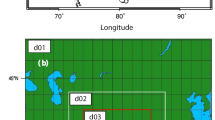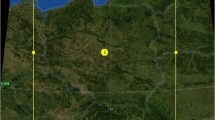Abstract
Heat-waves are strongly connected with environmental, health and socioeconomic impacts. The frequency of occurrence and the intensity of those events tend to increase across the Mediterranean due to climate change. Numerical weather prediction models are considered to be an important tool for predicting heat-wave events. Additionally, they are suitable for studying human biometeorology. The aim of this paper is to evaluate the performance of the Weather Research and Forecasting (WRF) model under different physical options during heat-wave events taking place in the greater area of South–East Mediterranean, considering also the impacts on human thermal comfort. For this, 15 heat-wave events (52 total heat-wave days) were identified in a 10-year period (2004–2013). Seven (7) alternative model configurations were tested on a 6 km horizontal resolution domain and the results for air temperature, wind speed and vapor pressure were compared against ground-based observations. The micro-scale RayMan model was also employed, in order to evaluate predictions of the Universal Thermal Climate Index (UTCI). Results show that under certain physics options WRF is capable of reproducing successfully the key characteristics of the examined heat-wave episodes.
Access provided by CONRICYT-eBooks. Download conference paper PDF
Similar content being viewed by others
Keywords
- Numerical Weather Prediction Model
- Universal Thermal Climate Index
- Human Thermal Comfort
- Thermal Bioclimate
- Turkish State Meteorological Service
These keywords were added by machine and not by the authors. This process is experimental and the keywords may be updated as the learning algorithm improves.
1 Introduction
Under the background of global warming and because of other factors, such as urban heat island effects (Giannaros et al. 2013, 2014), heat-wave (HW) episodes occur frequently worldwide (Zeng et al. 2011), resulting to severe implications on human health, environment, agriculture and economy. Further, the intensity of HWs tends to increase, especially over regions of southeastern Europe (Founda and Giannakopoulos 2009).
Numerical weather prediction models are widely used to examine and assess HW events and to estimate human thermal discomfort. More specifically, a variety of studies have been carried out using the mesoscale meteorological Weather Research and Forecasting (WRF) model to improve its skills under extreme hot weather conditions (Zeng et al. 2011, 2014).
The aim of this paper is to contribute to this intensive effort by evaluating the performance of WRF under different physics parameterization options during selected HW episodes over the greater area of southeastern Mediterranean and by investigating the relative impacts on human thermal comfort.
2 Data and Methodology
2.1 Meteorological Datasets and Definition of HW Episodes
Ground-based meteorological observations at routine World Meteorological Organization (WMO) stations were obtained from five different monitoring networks: Hellenic National Meteorological Service (HNMS), Republic Hydrometeorological Institute (RHI, FYROM), National Institute of Meteorology and Hydrology (NIMH, Bulgaria), Turkish State Meteorological Service (TSMS) and Servizio Meteorologico (SM, Italy). In total, 60 stations were selected, in order to fulfill the needs of the present study. The selection was based on data availability, and to represent the study area to the greater possible extent.
The identification of a HW day was based on IPCC’s definition of extreme temperature index, TN90p (IPCC 2013). Following this, a warm day is defined when daily maximum temperature exceeds the 90th percentile of a late-20th century reference period (1961–1990). This criterion was applied to the meteorological data of three (3) stations: Elliniko (Athens), Larissa and Thessaloniki. When at least three (3) consecutive HW days were identified at the same time at the above stations, then a HW episode was defined. Totally, 15 HW events (52 total HW days) were identified in a 10-year period (2004–2013).
2.2 Implemented Models and Experimental Design
WRF was applied over two 2-way nested modeling domains. The outer domain (d01), having a 18 km horizontal grid resolution (mesh size of 320 × 220), covers most of Europe and North Africa and is used for simulating synoptic-scale conditions. The inner domain (d02), having a spatial resolution of 6 km (mesh size of 250 × 190), focuses on southeastern Mediterranean and the Balkan Peninsula. Both modeling domains have the same vertical structure that includes 28 layers, covering the whole troposphere. The WRF simulations were driven by the 0.25° × 0.25° spatial resolution and 6 h temporal resolution operational surface and upper level atmospheric analysis data of the European Center for Medium-range Weather Forecasts (ECMWF).
The WRF model has a wide range of physics options, which allow fine-tuning the model to better describe various physical processes. In the current work, a series of experiments changing one option at a time for (1) Planetary Boundary Layer/Surface Layer and (2) Land Surface Model have been implemented. In total, four different PBL/Surface Layer combinations and four different LSMs have been tested in the present study (Table 1). 84-h simulations were carried out for each identified HW episode, providing output every hour. The first 12 h of each simulation are treated as spin-up period, while the remaining 72 h are used for the evaluation of the model.
RayMan model simulates radiation fluxes in simple and complex environments. The final output of the model is the mean radiant temperature (Tmrt), that is necessary for deriving thermal bioclimate indices, such as the Universal Thermal Climate Index (UTCI) (Matzarakis et al. 2007, 2010). UTCI is expressed as an equivalent temperature (°C) of a reference environment, providing the same physiological response of a reference person as the actual environment (Blazejczyk et al. 2012). In the present study RayMan was driven by ground-based observations and WRF-simulated data of air temperature, vapor pressure, wind speed and cloud cover.
3 Results and Discussion
Domain-wide statistics can provide an overall performance measure on the capability of the model to reproduce observations. Table 2 is a compilation of the computed model performance metrics [i.e. Mean Bias (MB), Mean Absolute Error (MAE), STandard Deviation of Error (STDE), Index Of Agreement (IOA)] for PBL/SL scheme experiments.
The Revised-MM5 SL Scheme exhibits the best statistical results for temperature, which are slightly even better, when this physics option is combined with ACM2 PBL Scheme. ACM2 Scheme produces lower bias (−0.11 m/s) for wind speed, while YSU-Revised MM5 run shows the best results for MAE and STDE. The largest MAE and STDE are reported for vapor pressure, indicating that the model lacks ability in simulating this variable. Concerning the evaluation of discomfort conditions, YSU-MM5 run shows the best performance in predicting UTCI.
Results for the four LSM experiments are shown in Table 3. As shown in this Table, Noah LSM shows better results for all meteorological variables and for UTCI. On the other hand, RUC model results in the largest MB for both temperature and UTCI. Noah LSM underestimates vapor pressure, while the other LSMs result to overestimation.
4 Concluding Remarks and Future Prospects
In the present study, four widely used PBL/SL Schemes and LSMs have been statistically evaluated for their skill to forecast the key meteorological characteristics of HW episodes over the greater area of SE Mediterranean and Balkan Peninsula. The evaluation also aimed to investigate the relative impacts on human thermal comfort.
In general, the model was found to be biased cold, underestimating UTCI by −1.03 °C in the YSU-Revised MM5 run to −1.62 °C in the RUC LSM run. The analysis for PBL/SL sensitivity runs showed mixed results for the different examined parameters. YSU-MM5 PBL/SL scheme can be selected as the most accurate. This selection is based on the slight advantage of this option to produce lower MAE (2.81 °C) and STDE (3.42 °C) for UTCI. The results are more clear for the LSM sensitivity runs. Noah LSM showed good adequacy in replicating all the examined parameters.
Based on the above results, it is in the authors’ plans to further investigate the role of PBL/SL schemes and LSMs in the WRF model forecast accuracy during HW events. More specifically, a categorization of the statistical measures in terms of region, geography and land use is necessary. Furthermore, a statistical investigation of daily maximum, minimum and average values of the examined meteorological parameters will reveal more evidences about the different responses of the model.
References
Beljaars ACM (1995) The parametrization of surface fluxes in large-scale models under free convection. QJR Meteorol Soc 121:255–270. doi:10.1002/qj.49712152203
Benjamin SG et al (2004) Mesoscale weather prediction with the RUC hybrid isentropic-terrain-following coordinate model. Mon Wea Rev 132:473–494. doi:10.1175/1520-0493(2004)132<0473:MWPWTR>2.0.CO;2
Blazejczyk K et al (2012) Comparison of UTCI to selected thermal indices. Int J Biometeorol 56:515–535. doi:10.1007/s00484-011-0453-2
Founda D, Giannakopoulos C (2009) The exceptionally hot summer of 2007 in Athens, Greece—a typical summer in the future climate. Global Planet Change 67:227–236. doi:10.1016/j.gloplacha.2009.03.013
Giannaros TM et al (2013) Numerical study of the urban heat island over Athens (Greece) with the WRF model. Atmos Environ 73:103–111. doi:10.1016/j.atmosenv.2013.02.055
Giannaros TM et al (2014) Development of an operational modeling system for urban heat islands: an application to Athens, Greece. Nat Hazards Earth Syst Sci 14:347–358. doi:10.5194/nhess-14-347-2014
Hong SY, Noh Y, Dudhia J (2006) A new vertical diffusion package with an explicit treatment of entrainment processes. Mon Wea Rev 134:2318–2341. doi:10.1175/MWR3199.1
IPCC (2013) Working group I contribution to the IPCC fifth assessment report. Climate change 2013: the physical science basis. Annex III: glossary
Janjic ZI (2002) Nonsingular implementation of the Mellor–Yamada level 2.5 scheme in the NCEP Meso model. NCEP Office Note 437:61
Jiménez PA et al (2012) A revised scheme for the WRF surface layer formulation. Mon Wea Rev 140:898–918. doi:10.1175/MWR-D-11-00056.1
Lawrence DM et al (2011) Parameterization improvements and functional and structural advances in version 4 of the community land model. J Adv Model Earth Syst 3:M03001. doi:10.1029/2011MS000045
Matzarakis A, Rutz F, Mayer H (2007) Modelling radiation fluxes in simple and complex environments—application of the RayMan model. Int J Biometeorol 51:323–334. doi:10.1007/s00484-006-0061-8
Matzarakis A, Rutz F, Mayer H (2010) Modelling radiation fluxes in simple and complex environments: basics of the RayMan model. Int J Biometeorol 54:131–139. doi:10.1007/s00484-009-0261-0
Niu GY et al (2011) The community Noah land surface model with multiparameterization options (Noah-MP): 1. Model description and evaluation with local-scale measurements. J Geophys Res 116:D12109. doi:10.1029/2010JD015139
Pleim JE (2007) A combined local and nonlocal closure model for the atmospheric boundary layer. Part I: Model description and testing. J Appl Meteor Climatol 46:1383–1395. doi:10.1175/JAM2539.1
Tewari M et al (2004) Implementation and verification of the unified NOAH land surface model in the WRF model. In: Proceedings of 20th conference on weather analysis and forecasting/16th conference on numerical weather prediction, Seattle, WA. Amer. Meteor. Soc., pp 11–15
Zeng XM et al (2011) Sensitivity of simulated short-range high-temperature weather to land surface schemes by WRF. Sci China Earth Sci 54:581–590. doi:10.1007/s11430-011-4181-6
Zeng XM et al (2014) Sensitivity of high-temperature weather to initial soil moisture: a case study using the WRF model. Atmos Chem Phys 14:9623–9639. doi:10.5194/acp-14-9623-2014
Author information
Authors and Affiliations
Corresponding author
Editor information
Editors and Affiliations
Rights and permissions
Copyright information
© 2017 Springer International Publishing Switzerland
About this paper
Cite this paper
Giannaros, C., Melas, D., Giannaros, T.M. (2017). Evaluation of WRF Parameterization Schemes During Heat-Wave Events Over the Greater Area of South–East Mediterranean. In: Karacostas, T., Bais, A., Nastos, P. (eds) Perspectives on Atmospheric Sciences. Springer Atmospheric Sciences. Springer, Cham. https://doi.org/10.1007/978-3-319-35095-0_3
Download citation
DOI: https://doi.org/10.1007/978-3-319-35095-0_3
Published:
Publisher Name: Springer, Cham
Print ISBN: 978-3-319-35094-3
Online ISBN: 978-3-319-35095-0
eBook Packages: Earth and Environmental ScienceEarth and Environmental Science (R0)




